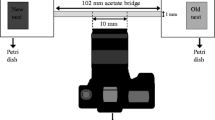Abstract
We present a detailed behavioral analysis of the signals involved in recruitment of 11 syntopic Polyrhachis species from West Malaysia. We found a considerable variety of recruitment techniques, including “social carrying behavior,” “tandem running,” “group recruitment,” and a technique which we call “leader-independent trail communication.” The latter mode superficially resembles “chemical mass communication” (sensu Wilson, 1962). All these recruitment techniques involve mechanical invitation behavior inside the nest, comprising back-and-forth jerking or pulling movement often combined with a sideways waggling. However, not in all cases of leader-independent trail communication is a mechanical invitation behavior obligatory. The trail pheromone of all investigated Polyrhachis species originates from the hindgut. Only in the tandem running P. proxima do additional secretions from the poison gland appear to be involved in tandem calling.
Similar content being viewed by others
REFERENCES
Dejean, A., Lenoir, A., and Godzinska, E. J. (1994). The hunting behavior of Polyrhachis laboriosa, a nondominant arboreal ant of the African Equatorial forest (Hymenoptera: Formicidae, Formicinae). Sociobiology 23: 293-313.
Hefetz, A., and Lloyd, H. A. (1982). Exocrine glands of Polyrhachis simplex: Chemistry and function. J. Chem. Ecol. 8(3): 635-639.
Hölldobler, B. (1971). Recruitment behavior in Camponotus socius (Hym. Fromicidae). Z. Vergl. Physiol. 75: 123-142.
Hölldobler, B. (1974). Communication by tandem running in the ant Camponotus sericeus. J. Comp. Physiol. 90: 105-127.
Hölldobler, B. (1981). Foraging and spatiotemporal territories in the honey ant Myrmecocystus mimicus Wheeler (Hymenoptera: Formicidae). Behav. Ecol. Sociobiol. 9: 301-314.
Hölldobler, B., and Wilson, E. O. (1997). The multiple recruitment systems of the African weaver ant Oecophylla longinoda (Latreille) (Hymenoptera: Formicidae). Proc. Natl. Acad. Sci. USA 74(5): 2072-2075.
Hölldobler, B., and Wilson, E. O. (1990). The Ants, The Belknap Press of Harvard University Press, Cambridge, MA.
Hölldobler, B., Möglich, M., and Maschwitz, U. (1974). Communication by tandem running in the ant Camponotus sericeus. J. Comp. Physiol. 90: 105-127.
Horstmann, K., Bittner, A., and Ulsamer, P. (1982). Nahrungsalarm bei Waldameisen (Formica polyctena Förster). Insectes Soc. 29(1): 44-66.
Liefke, C., Dorow, W. H. O., Hölldobler, B., and Maschwitz, U. (1998). Nesting and food resources of syntopic species of the ant genus Polyrhachis (Hymenoptera, Formicidae) in West-Malaysia. Insectes Soc. 45: 1-15.
Mercier, J.-L. (1992). Structure sociale et utilisation du milieu chez Polyrhachis laboriosa (Hymenoptera: Formicidae), DEA thesis, Universite Paris-XIII, Paris.
Möglich, M., and Hölldobler, B. (1974). Social carrying behavior and division of labor during nest moving in ants. Psyche 81(2): 219-236.
Möglich, M., and Hölldobler, B. (1975). Communication and orientation during foraging and emigration in the ant Formica fusca. J. Comp. Physiol. 101(4): 275-288.
Traniello, J. F. A. (1977). Recruitment behavior, orientation and organization of foraging in the Carpenter ant Camponotus pennsylvanicus DeGeer (Hymenoptera: Formicidae). Behav. Ecol. Sociobiol. 2: 61-79.
Traniello, J. F. A. (1989). Chemical trail systems, orientation, and territorial interactions in the ant Lasius neoniger. J. Insect. Behav. 2(3): 339-354.
Wilson, E. O. (1959). Communication by tandem running in the ant genus Cardiocondyla. Psyche 66(3): 29-34.
Wilson, E. O. (1962). Chemical communication among workers of the fire ant Solenopsis saevissima (Smith). 1. The organisation of massforaging. Anim. Behav. 10: 134-147.
Author information
Authors and Affiliations
Corresponding author
Rights and permissions
About this article
Cite this article
Liefke, C., Hölldobler, B. & Maschwitz, U. Recruitment Behavior in the Ant Genus Polyrhachis (Hymenoptera, Formicidae). Journal of Insect Behavior 14, 637–657 (2001). https://doi.org/10.1023/A:1012227318159
Issue Date:
DOI: https://doi.org/10.1023/A:1012227318159




